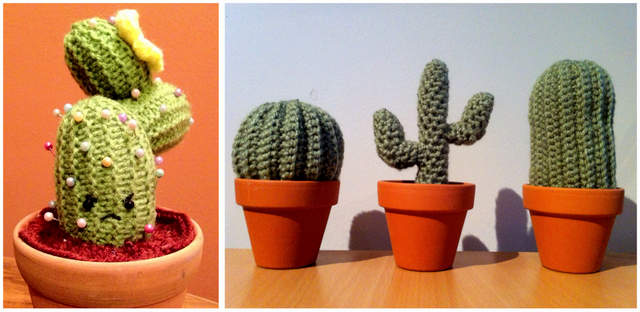A Beginner’s Guide to Establishing a Queer Houseplant Utopia
Look: you’re here, you’re queer; you deserve to live in a queer houseplant utopia. You deserve to come home to a room that’s been stripped of carbon dioxide by your own personal army of devoted plant friends; at night, you deserve to be carried off toward gentle slumber upon the frothy waves of oxygen emitted by your most trusted plant coven. In addition to cleaning the air, plants lend color and texture to a room; they also objectively make you seem like some kind of earthy sun goddess, the best possible version of yourself, someone who always packs an umbrella and eats a healthy amount of yogurt. Everything is possible with plants!
“But Allie,” you cry, “I have no experience with these creatures. How is it even possible to bring plants, one of the villains of the film Jumanji, into my home?”
Starting your own queer houseplant utopia can feel daunting, but it doesn’t have to be. This is a guide for those of you who have always found the idea of growing plants exciting, but have never felt confident enough to give it a shot, written by a person whose only qualification is talking laughing loving breathing in a studio full of 30-odd plants. I’m going to give you a brief explanation of what plants need to be happy indoors, followed by a list of some of the easiest plants to keep alive, and ending with some tips you can use to fill your space with all the plants your heart desires. This guide is by no means exhaustive – there are so many plant things about which I am, sadly, clueless; for example, do all succulents yearn for death, or just mine? – but it is instead meant to help inspire you to start transforming your space into a mean, green, photosynthesis factory.
How to keep a plant alive
Ultimately, plants are just like humans: they need plenty of sunlight and water, they respond well to kind words and good music, and they will die if they are only given cut-up hot dogs and La Croix. The easiest way to keep a plant alive is to assess the conditions of your living space and then purchase a plant that will thrive under those conditions. When making this assessment, there are a few different factors to keep in mind:
Light
Does your living space get a lot of light? Is the light bright or dim? Direct or indirect? Are there windows that face east or west, which will give your plants lots of time to hang out with the sun, or do they mostly face north or south, which are widely known as the sun-fearing directions? Is there perhaps too much sun in your place, such that certain plants placed directly on a windowsill may get scorched? There are certainly many shy, bookish plants that do well in low-light conditions, so don’t despair if you look around and suddenly realize that your home is sunless because you have no windows because you live in a damp French wine cellar because you are a little rat who loves to cook.
Water
Most plants want to be watered at regular intervals in which they can take a nice deep drink of water and then have the rest drain away so they don’t drown. The frequency and intensity of each watering varies from plant to plant, however, with some requiring abundant waterings and mistings and others only needing to be watered very rarely. When picking a plant for your space, take your dedication into consideration – a delicate fern may be a beautiful addition to your space, but if you know you’re going to be too busy gossiping and playing the French horn to carefully monitor the moisture of your fern’s soil, that plant is going to die and you are going to be sad about it.
Other complications
These include considerations like children, pets, and anything else not covered by the big two categories above. For example: my sweet little perfect cat Meryl also happens to be a hobgoblin who was once cast out of Hell for nibbling on all of Satan’s plants and now likes to play with mine. Ergo, I make sure anything that’s toxic to cats is hanging far out of her reach, I keep a close eye on all my cat-level plants for signs of interference, and I make numerous blood sacrifices to her brethren in the kingdom of Hell to help keep her paws out of mischief.
What plants should I start with?
Scientists agree: there are many different kinds of plants, just like, in general, in the world. Here are three plants that are great choices for starting your queer houseplant utopia. These plants are the lowest-maintenance, chillest of the chill, easiest to please plants around. These plants are Kristen-Stewart-lounging-on-a-yacht chill. If you, Internet stranger, are capable of making toast, then you can keep these plants alive.
Snake plant
Also known as “mother-in-law’s tongue”, a term that was probably meant to be sexist but now sounds totally bitchin’, snake plants are very rad and very difficult to kill. They’re my go-to plant recommendation to people who have never had a plant before and are worried that anything green they touch will somehow end up a smoldering pile of ashes. Snake plants need low light and very little water, and they generally thrive on neglect. They’ve also been demonstrated to purify air by removing CO2 and other chemicals from the air and releasing oxygen at night, making them ideal plants for the bedroom. Plus, every snake plant looks like the spaceship that once delivered Tilda Swinton to Earth, which is a cool bonus.
ZZ plant
Known as the zed-zed plant, probably, in the UK, the ZZ plant is another great beginner plant. It doesn’t need a lot of light or a lot of water, and its new branches unfurl in a very cool spiral-y way. I have only managed to kill one ZZ plant so far, but it was because I dramatically overwatered it, thus condemning it to a watery grave. Don’t be like me! Let the soil get nice and dry before you water these lil’ curly boys.
Pothos
I love pothos. They’re the kind of hanging plants that grow so long and viney and fabulous that I am pretty sure they’re going to try to strangle me in my sleep one day. I can’t get enough of them. Plus, it’s easy to tell when they need to be watered – their leaves get all limp and dangly when they’re thirsty, which means you can just kind of feel the leaves and murmur, “Hmm, feels like this needs to be watered” and whoever you’re with will be like, “who is this magnificent creature, this veritable plant whisperer, this magician of soil and wind?” and that’s how you earn people’s respect and maybe even get laid once in a while.
How to get plants and display them nicely
Finding plants, especially in this day and age, is pretty easy. I’d recommend starting by looking for a local nursery with a knowledgeable staff that can help you pick the perfect plant for your home and lifestyle. For example, I’m constantly swinging by my favorite plant store and asking, “I’ve been spending a lot of time crying to Tori Amos this week, what’s a plant that’s cool with that?” and they’re always very nice and let me do whatever I want as long as I don’t get Cheeto dust on any of the plants. Anyway, if there’s not a great nursery near you, you can always try Home Depot or another big chain store, with the caveat that the quality of their plants will probably vary pretty widely.
Feel free to plant your new friends in whatever beautiful pots or cups or mugs your heart desires, but remember: the easiest way to kill most houseplants is by overwatering them, so it’s crucial to make sure your pots have drainage. You can achieve this by planting in a pot that has holes or by keeping your plant in its original plastic nursery container, nestling it inside a larger pot, and then removing it to do your watering in the sink or shower.
More resources
Apartment Therapy is a great site for learning more about specific plants and how to care for them; they’re also a great resource if you’re looking to buy new plants and planters. I like to look at their house tours to see how other people display their plants and then I steal their ideas like I’m Jude Law in that movie where he plays a thief (that may have actually just been a dream I had?).
The Sill has some good plant care tips and is also a great place to buy a plant and/or planter. I bought a snake plant from the Sill for my sister’s birthday and it arrived at her apartment in good condition and is still going strong a few months later and if it’s good enough for her why shouldn’t it be good enough for you?!
The Spruce is another good source of information about houseplants; they also have a lot of information about gardening in case your houseplant garden begins to flourish so dramatically that you decide to expand your leafy dominion outdoors.
A final word
You’re going to kill some plants. I’m so, so sorry, but it’s true. You’re going to buy some lovely plants and do absolutely everything right and water them and give them sun and play them Steely Dan records and whisper kind things to them at night and then one day you’re going to realize you’ve been overwatering them this whole time and their leaves are going to turn yellow and brown and one day you’ll wake up with a sad, soggy plant corpse. It happens. Learn from your mistakes. Don’t be afraid to buy a new plant, or ask for a new cutting from a friend, and try again. You’ll get the hang of it. And it’ll all be worth it when you can come home to your very own queer hobbit hole full of plant friends. Happy planting!
What Kind of Houseplant You Should Get Depending On Your Flavor of Lesbianism
Apprently millennials have a houseplant obsession, but whether or not you’re a millennial, houseplants can really spruce up a living space, especially if you live in a city and don’t have easy access to outdoor greenery. It’s well-documented by Science*, though, that after your “saturn return,” aka your late twenties/early thirties, owning (a) houseplant(s) somehow happens to almost all of us, usually without warning. Especially gays!
For a lot of lesbians, our outward gender presentation has almost NOTHING to do with how we behave in a relationship or in the bedroom. I’ve known some hard butches/studs who were total bottoms and/or sweethearts, and some femmes who were more of a fuckboi than any straight dude. This is well established. Science* has also discovered, however, that your flavor of lesbianism corresponds ONE HUNDRED PERCENT with the type of houseplant that will do well in your home! Who knew?
Recently turned thirty and have an urge of indeterminate origin to adopt a houseplant? Recently moved in with bae and want to decorate? Mourning a lost love and want something to take care of? Passed by one of the new hip plant stores in the gentrified part of your city and want to get some beautiful foliage before they go out of business? Regardless of your reason, here’s your guide to which houseplant will fit your personal flavor of lesbianism!
Snake Plant

Snake plants (also known as “Mother-In-Law tongue” for some reason?) are very hardy and resilient. They also don’t require much watering, and can survive in low-light areas. Downside: many pets are allergic.
If you just don’t have the TIME to take care of a plant — let’s say you’re an artsy punk lesbian who lives in a basement (no natural light!) and are out at a concert every night, or frequently sleep over at a dirty new lover’s mattress on the floor of their shared room — check out a Snake plant. The name is really punk too!
Rubber Tree
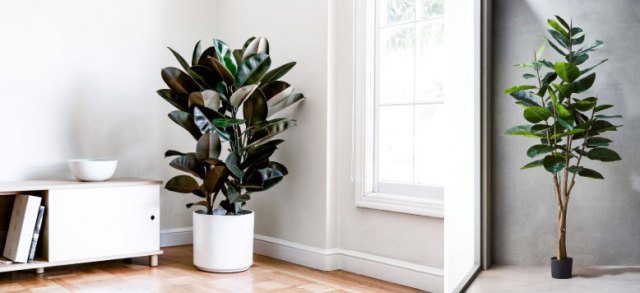
If you’re an upwardly-mobile, childfree, high-powered lesbian in a minimal loft, but you kind of want something to take care of because that maternal instinct is kicking in, a Rubber Tree might be for you. Adopt a Rubber Tree when it’s young, because then it will adapt better to your living environment — which should be consistent. They’re good for home or condo owners too, because they can grow TALL. Up to 50 feet! But more likely six to ten feet, the perfect accent piece for the modern post-deco revival upscale thrift store chic thing you’ve got going on.
They need indirect sunlight, so a full-length window with a sheer curtain over it is great. You also have to spritz them with water as well as water them regularly in the summer, but they’ll tell you if you’re doing it wrong — the leaves will turn brown and slowly die! Rubber Trees are just like children, but slightly easier. Perfect for you.
Boston Fern

I think you should avoid getting a Boston Fern unless you’re a masochist. You need to plant them in a mixture of peat moss, sand, and regular soil. They like to live in a warm, humid environment between 65-75° during the day and between 55-65° at night. You might need a humidifier. They need the perfect amount of indirect sunlight. They need to be spritzed with water daily. They need to be fed with fertilizer regularly. They need to be pruned. They can get pests.
If you’re a lesbian into having your life controlled by the whims of a finicky, demanding partner or dom or whoever, maybe you want a fern?
Succulents

Succulents are the go-to low maintenance houseplant. They’re basically cacti. You could plant them in your front yard and they’d probably be fine when you come back to look at them a month later. If you’re a low-maintenance lesbian who likes to see your partner or date once a week at most and aren’t really into processing or caretaking, a Succulent may be for you!
Downside: they will easily die if you over-water them! Do you vacillate between extreme distance, and then U-Hauling/merging/clinginess/overdoing it? Then watch out. Succulents like consistent LACK of attention.
Monstera
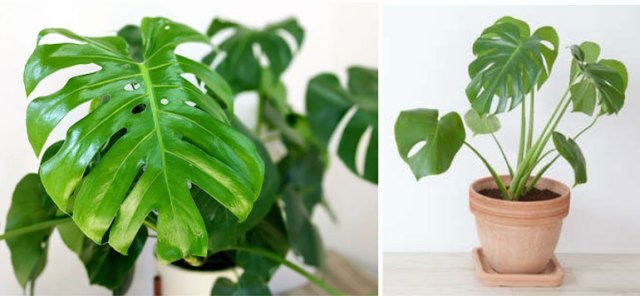
Also known as a “cheese plant,” monsteras are lovely and quirky. These are pretty average in terms of maintenance, if you have the right climate for them (they’re tropical). They can’t get too much sun but need warmth. You’re also supposed to wash the leaves every couple weeks! But they can irritate skin, so wear gloves while doing it?
If you have pretty moderate relationship expectations — you generally want to be comfortable, are fine with taking care of someone who’s pretty much fine on their own but does like your company, and aren’t looking for something low-maintenance and casual OR extreme caretaking, check out a Monstera!
Lucky Bamboo
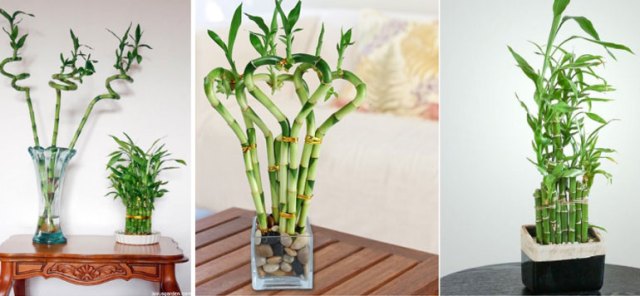
Lucky Bamboo are cute, quirky, and simple (and aren’t actually a type of bamboo, apparently). You can even train them to grow into a little heart shape! They don’t even need soil. Perfect for your uncomplicated love life. If you’re a hopeless romantic lesbian who focuses on the positive, loves cute things, and just wants to be happy, these are for you! Watch out, though – they’re toxic to cats!
Fiddle Leaf
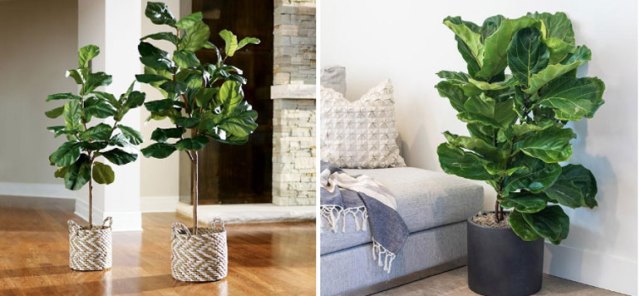
These are so trendy right now, and so beautiful. But unless you are the perfect caretaker, a Fiddle Leaf will die on you. Too much sun? It’ll wither. Too little? It’ll barely grow and eventually droop to death. Want to redecorate? Nope. They don’t adapt to change well at all.
If you’re a lesbian who knows exactly what you like, can make decisions and stick to them, keep everything in your life organized and consistent, have very clear boundaries, don’t do “messy” or drama, and prefer a date to the museum rather than the bar, get a Fiddle Leaf.
Air Plant

Air plants are the perfect hookup buddy/friend with benefits of the houseplant world. They don’t even need soil! Just spritz them with a bit of water every day or two. Or you can soak them in tap water every couple weeks — super easy because there’s no repotting or soil to deal with. Put them in a room that gets plenty of indirect sun — or they can even survive on fluorescent light! Be aware – they won’t live forever. Treat them like a much longer-lasting flower arrangement.
If you’re a “not looking for anything serious right now” — or ever — lesbian, and prefer focusing on yourself and not really taking on any additional emotional labor or caretaking or having to even think about a lover when you aren’t directly in front of them, and are only really here for short-term “arrangements” – get an air plant.
Orchids
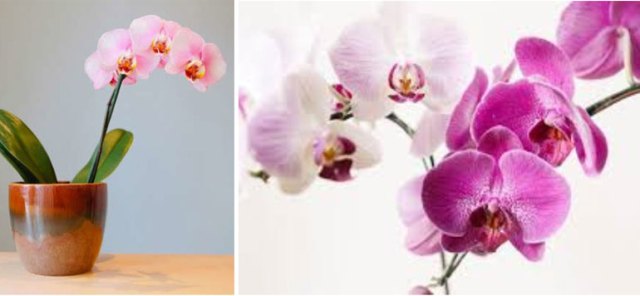
Orchids are delicate, finicky, gorgeous, and delicate. The care and consistent attention it takes to grow one and keep it alive is a Herculean challenge. They need bright but indirect sunlight, and sparse but specific watering. If you’re the type of lesbian who caretakes, who’s SO DOWN to give up everything to take care of your loved one, are attuned to their every mood, write them weekly love poems, and sit and gaze at their ethereal beauty when they grace you with their presence, then you want an orchid.
*Note: none of this is Science. It’s made up. Of course! Enjoy your plants!
13 Easy Houseplants for Seasonally Depressed Gays and Their Cats
I always feel like seasonal affective sadness gets worst for me in February — an arbitrary time, but maybe just the point at which my endurance for winter and snow and darkness and having to pack water and rations if I want to make the days-long trek to get, like, toilet paper and tortilla chips from CVS. While Heather, as always, has you covered with the actionable and practical tips, I am here with the band-aid ones that satisfy the seasonal depression urge to buy something, anything, so you feel alive again. For real, though, plants can make your living space or office space feel brighter and more alive when everything outside is cold and dead; caring for them can provide some helpful structure without being overwhelming; and some of them have (arguably negligible) air-purifying properties, which is nice to think about if you, like me, live somewhere so cold that opening the windows for fresh air is dicey.
Unfortunately, many of the truly chic house plants that Plant Instagram has convinced me will cure all that ails me are toxic to pets, and having to pay $700 to bring my cat to the vet in a Minnesota snowstorm without a car is definitely going to make me feel worse, not better. So no monsteras or birds of paradise for me, unfortunately, or maybe for you. But there are so many options left for beautiful, easy-to-care for houseplants that will make you feel more like there’s life in the world and motivate you to care about something without being so demanding that you want to break up with it by telling it you just really aren’t in a place to commit to anything right now! Here are some of them.
Pilea peperomides
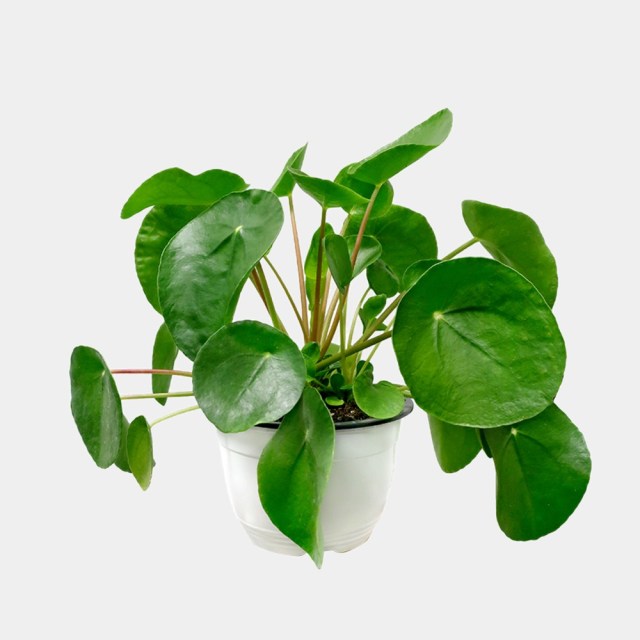
These are very hip on Plant Instagram right now, and for good reason! They’re unique-looking and pretty, easy to take care of, and have the added bonus of propagating new baby plants inside their pot, which can be replanted elsewhere or gifted.
Friendship Plant
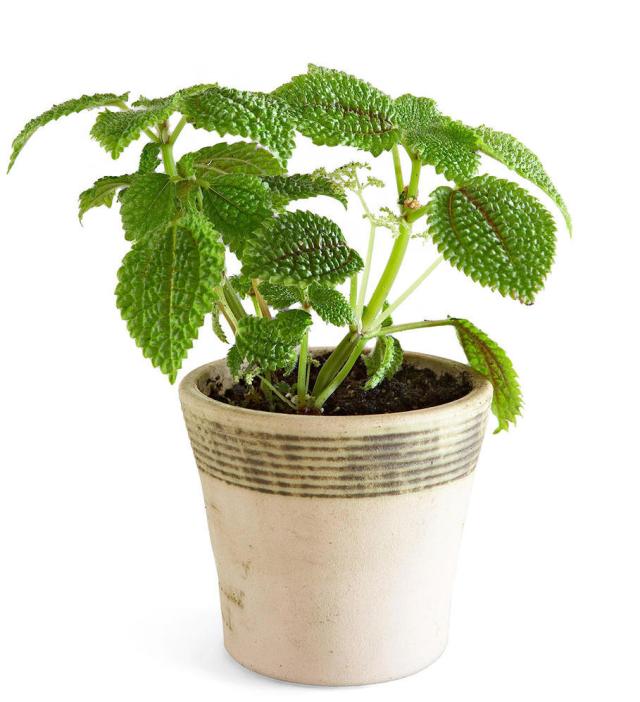
Much like friendship itself, this plant is cute and pleasant, just enough work in terms of maintenance, and won’t kill your pets. It’s easy to grow from cuttings, which means once you have a healthy one, you can easily share new plants with your pals or with cuties whose level of commitment issues you’re trying to evaluate.
(Some) Succulents
(Blue Echeverria, Burro’s tail, Zebra Haworthia, Sempervivum)
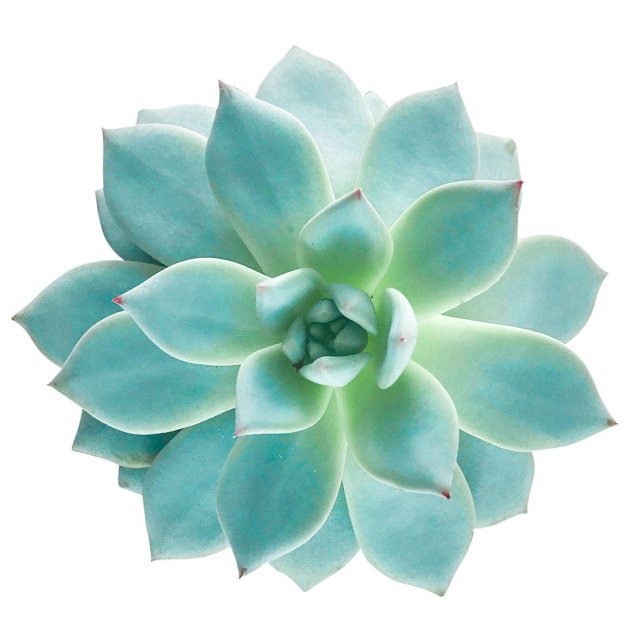
Succulents are a great go-to depression plant because they’re beautiful and make spaces greener with an EXTREME minimum of care; forgetting to water them is, in most cases, the best thing you can do for them. The only time a succulent is maybe not the right choice for you is if you live in a very dim environment or if your particular brand of coping mechanism means that you would overwater them. Despite their near-perfection in other ways, some kinds of succulents are in fact toxic to animals; these species are not, and are also very aesthetically pleasing!
Baby Rubber Plant

Some rubber plants are (somewhat) toxic to pets; this one is not, and also the tiny leaves are alarmingly adorable in a way that triggers the same hormonal response in me as like, a comically small reproduction of a normal object like a frying pan.
Boston Fern

A surprising number of ferns are toxic to cats, which is unfortunate as they are basically built like cat toys. This one is not! You can buy it only to have them completely tear it to ribbons and everyone’s needs here will be met. Except maybe the plant’s.
Prayer Plant
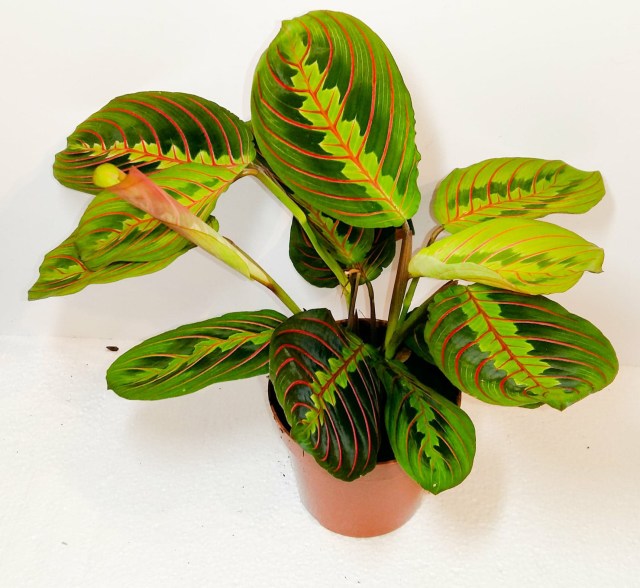
For aesthetic gays, the variegated leaves on the prayer plant will be very satisfying among a sea of plain green leaves or just your dirty laundry, whichever. A neat fact about prayer plants is that their name comes from the way leaves fold closed at night, like hands folding together in prayer, which is a helpful marker of time if your days have become an indistinguishable, timeless haze ever since the sun started setting at 4 pm.
Christmas Cactus

The Christmas cactus looks kind of like amaryllis, a popular plant which will unfortunately poison your pets. Not only will the Christmas cactus not poison your pets, but it will bloom once a year during the holiday season, which will hopefully alleviate a little bit of seasonal depression and the fact that your parents still call your girlfriend your roommate at Christmas.
Areca Palm

For large, dramatic floor plants that make you feel like you’re living in a rainforest and are seeing sunlight on a regular basis, nontoxic to pet options are unfortunately limited — but the areca palm is here for you, and your cat, and your desire to pretend that you’re in the first act of a Jurassic Park movie and can see graceful brontosaurus in the distance and also the sun is out, a powerful visualization technique against seasonal depression.
Parlor Palm
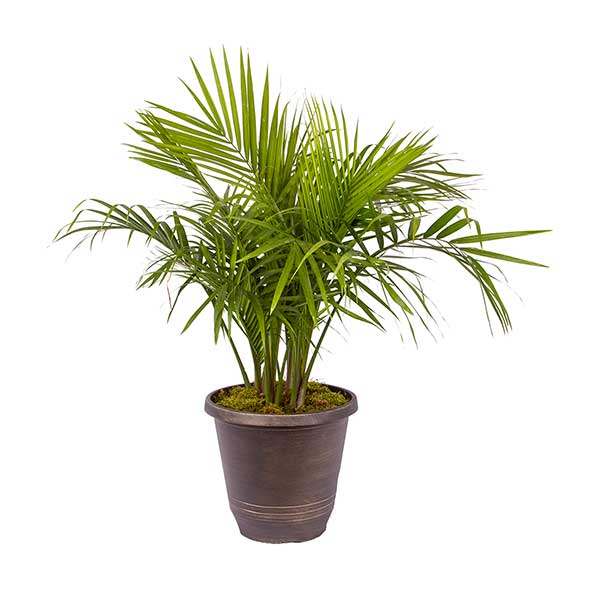
Parlor palms may look familiar from dentist waiting rooms, hotel lobbies and the like, part of why they have their name. They’re pretty, come in various sizes and are easy to care for as long as you have some level of humidity and medium to low light, as for other palm varieties. Parlor palms are very long-lived if well cared for, and can be “often passed from generation to generation,” a reassuring thought when time seems to have come to a standstill or at least a sort of Russian-Doll-esque endless loop of digging out your car.
Spider Plant
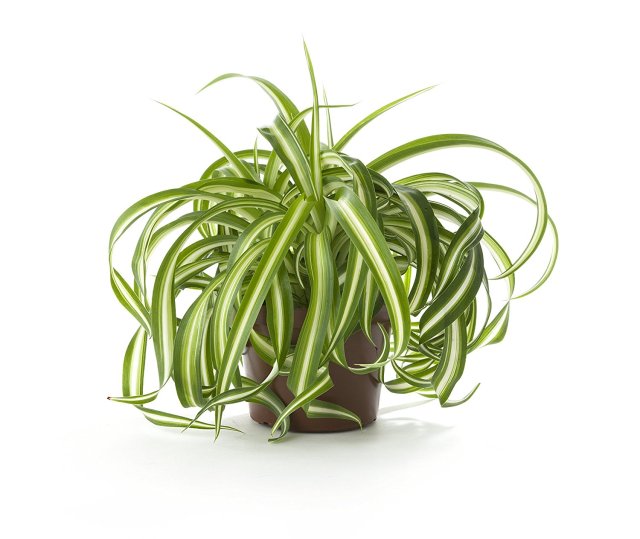
Are the claims that spider plants can ‘purify your air’ true? Allegedly, although you are said to need “a large amount of plants” for that to work, which may not be the amount of commitment you want — or maybe you’re a Cancer and overcommitting to 15 different spider plants is exactly what will get you through this winter, go with God. Spider plants are great hanging plants, which will give you something to look at if you’ve been spending a lot of time lying on the floor.
Ponytail Palm
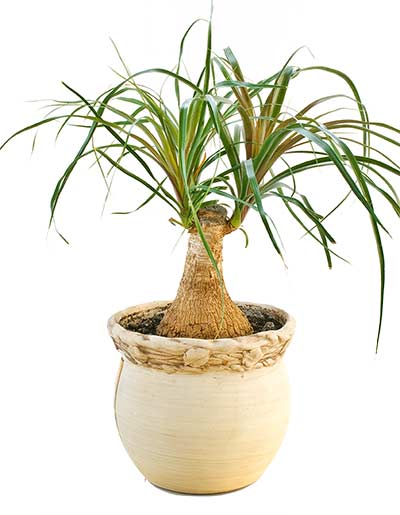
If you have always kind of wanted one of those ginseng plants they sell at IKEA and then stood on the IKEA showroom floor and googled whether they would poison your cat and then found that yes, it will, and once again had to leave IKEA with only a lighting accessory and one of those furry rugs they use on Game of Thrones — you will be pleased to know the ponytail palm looks sort of similar and will not poison your plant.
Cast-Iron Plant
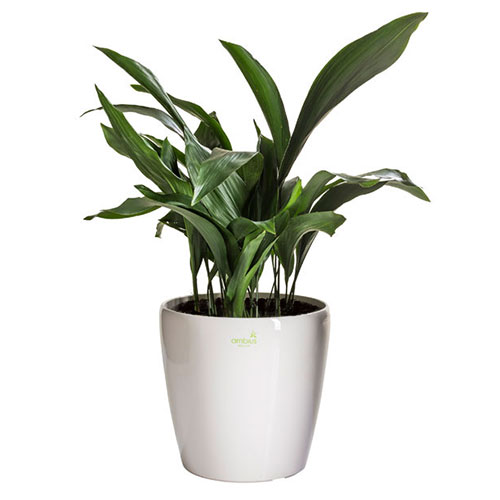
Cast-iron pans are essentially forever; even if you treat them horribly and let them rust beyond recognition, they can pretty much always be brought back to working order. Similarly, this plant is very hard to kill, and is large enough to be a nice floor plant, a change from the rest of the options here which are more cute tabletop situations. It’s also called the barroom plant for its ability to survive in less than hospitable environments, a good fit if you’re planning on smoking heavily or hosting karaoke in your apartment.
Air Plant
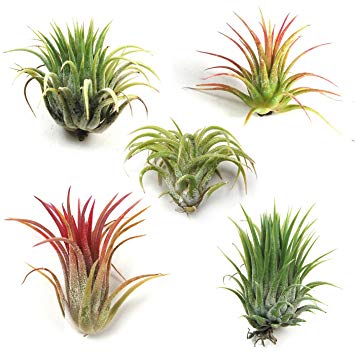
For those with real issues around commitment and caretaking, please consider the plant that doesn’t even need dirt and is described by this article as being “for those with a fear of houseplants.” Want to be able to pack up at any moment to go road tripping and play sad songs on the hood of your car about your ex-girlfriend? This plant can come.
For Your Consideration: Buying Another Houseplant That You Know Will Die
Welcome to For Your Consideration, a new series about things we love and love to do — and we’d like to give you permission to embrace your authentic self and love them too.
No, this is a good idea. Buy another houseplant. You’re already out, running errands. There are plants and here you are, near them. This pothos would look so cozy in the matte white clay planter, the one with the cable knit design. It’s 15% off today. You’ve been meaning to try macrame again, and the string of pearls thriving next to the spider plant over there is the perfect size for a beginner-level macrame plant holder. Imagine yourself propagating the string of pearls for a friend. You can give it to her in the boob planter you bought on Etsy. Buy another houseplant. Buy three.
Hope
This is hope that you feel, a hope that you’ve changed, somehow. That you’ve learned from past mistakes and have gained knowledge, like a Sims character reading book after book after book, her diamond filling with the facts and know-how that will take her to Level 2: Gardener. You are a being capable of learning, and of hoping. This isn’t belief so much as it is faith, and hope of course. Get another bag of soil.
Joy, If Fleeting
Put the plant into its container when you arrive home. You chose the container especially for this plant. It is a perfect fit. The ratio of tall to squat created by the plant inside the container is literally perfect. They — the plant and the container, together — coordinate beautifully with your home. A marriage of trendy and timeless. The sunlight hitting the leaves, the glimpse you catch of the two of them, plant and container, while you’re walking toward the kitchen, the way you imagine you must look with your watering can in the afternoon. This is joy.
Responsibility
Something tangible ties you to this mortal plane, and it is this houseplant. It needs you, needs water and pruning, needs vigilance. You will water and prune this plant. You’ll be vigilant about preventing pests from infesting and pets from chewing and small children from pulling or pushing and large boxes from toppling. You will open these drapes, here, so the sunlight can find its way to your object of responsibility.
Passage of Time
What day of what week is it now? You know. You know because it has been this many days since you last watered your houseplant, and this many days lie ahead of you until you will water it again. It has been this many weeks (entire weeks!) since you brought your houseplant home, which is this many weeks more or less than the last plant lived after its arrival. You are a shepherd of time in this space. You keep it and see it.
Cleaner Air
Breathe deep. The air is cleaner than it was before, thanks to your newest houseplant. Your air is cleaner. If you stepped outside your door and walked a distance and opened someone else’s door, would their air be this clean? Well that depends, doesn’t it, on how many houseplants they have. It’s likely your air is cleaner than theirs, though. Look at your houseplants.
Economy
It’s the economy, stupid. You know that. You know that when you receive money and then spend that money, you are bolstering the economy. You’re doing your part to keep businesses running, workers working. Each houseplant in your home, each houseplant hoping to be revived by the sunlight, each houseplant hoping to be saved by the shadows, each houseplant draining its water into a sink, each houseplant whose soil goes untended, represents a time when you have contributed to the economy. Be proud of your contributions.
Letting Go
Think about the day of the week, the week of the month, of the year. How long did this one last? This houseplant’s life was shorter than that houseplant’s, and longer than this one’s. It was just last week when you pruned it, you’ll note later, and maybe it was the pruning that sealed its fate. Was it too much access to sunlight? Could the culprit be in the type of soil you used. Does soil go bad. Did you go bad? No. No, you did not. You keep the lesson, vague as it may be at this moment, and you let go of the guilt. You let go of this houseplant.
Acceptance of Limits Even As You Push Them
What are you capable of in this life? What are your limitations, both imagined and enforced? What can you do? You know what you can do. You can contribute to an economy. You can mark the passage of time. You can breathe. You can imagine your life as a scene in a Nora Ephron film. You can find hope where others wouldn’t. You cannot, however, keep a houseplant alive. And you know. You know this.
Begin again.
Make A Garden Thing: Twig Plant Markers

Holy crap, it exploded into summer. My girlfriend just moved in and between the two of us we’ve amassed two dozen plants that are getting all sorts of bushy. Now they can’t keep their leaves to themselves, won’t stop poking each other in the areoles and are acting like the bratty children you imagine they’d be. Plant parenting is hard.
You could just lie to yourself and pretend you remember the difference between cilantro and parsley shoots, or you can just whittle some wood and let the plants do the talking. When it comes to leafy friends, you should name them so they feel special and don’t develop a complex and off themselves out of spite and loneliness. (RIP unnamed plant I forgot in the corner of my bedroom!) Or you know, label them by type.
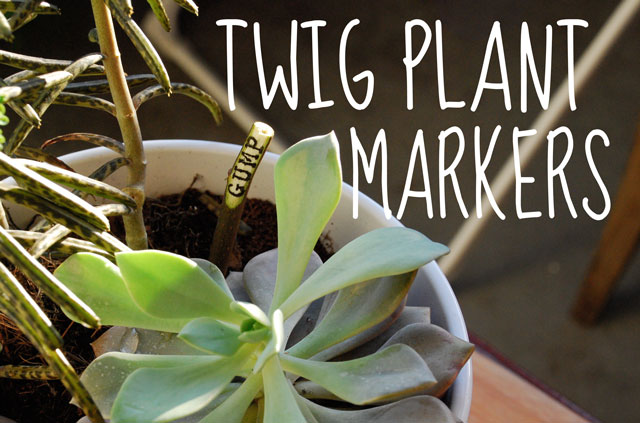
Is it morbid to make nametags out of dead relatives? Probably
To take a cue from Make A Thing, this is about as easy as peeling a carrot but slightly harder than labeling your pencil crayons. Did anyone else use scissors to scrape off the paint at the end? No? Maybe my mom just knew about my tendency to lose things and didn’t trust my eight-year-old peers.
Things You Will Need
+ A dead plant
+ A live plant
+ A saw, pruning shears, Stanley knife, etc.
+ A vegetable peeler or some fancy knife skills.
+ Permanent markers or lettering stamps and ink.
+ Sealant, clear lacquer, clear nail polish, top coat, etc
1. I say you need a dead plant because it’s mean to desecrate a live one. So go into the woods and collect some dry sticks about 1/4″ to 1/2″ in diameter. If you happen to have a plant that needs pruning, trim your topiary and let the cuttings dry out. Cut into 6″ lengths.
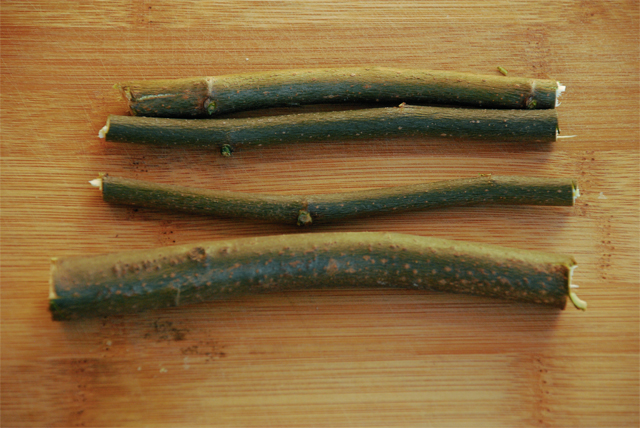
I looked out my window and my bush grew a foot-long branch in a week. I call him Jumangi for a reason.
2. Use your vegetable peeler (or impressive knife skills) to shave a patch off bark off from one of the ends. An inch and a half is a good start, but obviously you’ll need more space if your plant’s named Bubba Gump Shrimp the Third.
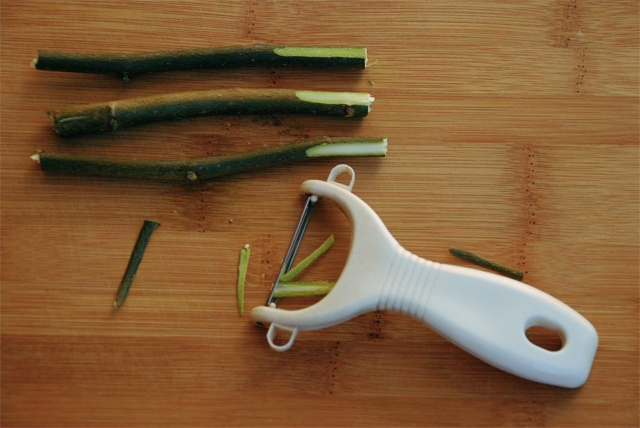
It’s almost as easy as cutting yourself!
3. Then start naming your plants! Use your best penmanship to write out the names. Or use a set of stamps to spell them out, causing your friends to be wonder if you shoved a twig in your typewriter. Or go hardcore and draw a plant portrait, so your tiny plant baby knows what to aspire to.
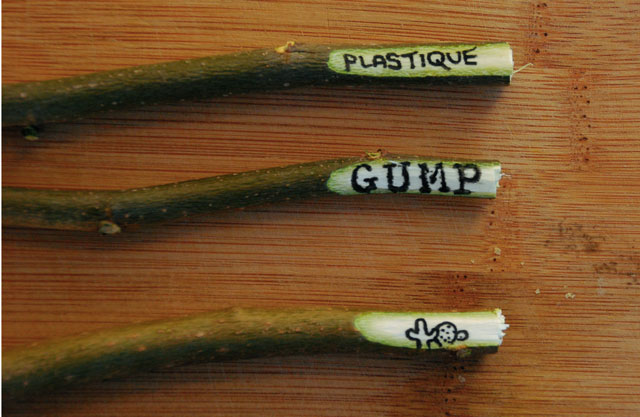
I never said we had a naming theme.
4. Apply a protective layer of spray or polish to prevent water damage to your twigs. You are totally going to remember to water this plant.
5. Put it in the pot! Just make sure you give it the right name, lest your plant becomes even more depressed.
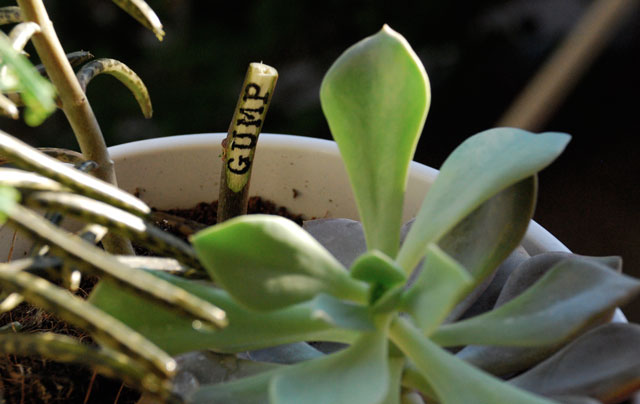
Now My Gump is Less of a Grump
Grow a Little Love: Making Plantable Paper Notecards
My mom is the queen of weird and fantastic presents. This year for Easter she mailed me a tiny greenhouse, basil seeds and henna. In an Easter basket. It’s tough keeping up with the most thoughtful lady in the land. Luckily I have the Internet on my team. A few weeks ago, seed paper poped up in my Google Reader and, at $3 a sheet, I thought, “I can make that.” You can make it too!
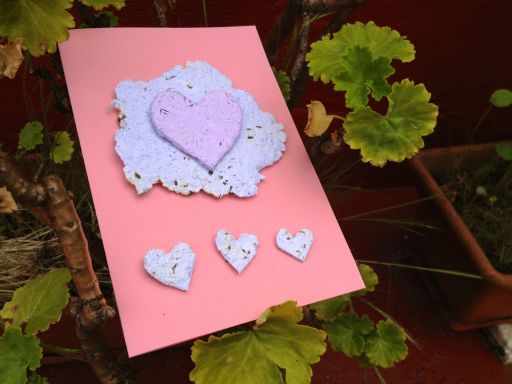
You Will Need:
+Old White(ish, text is fine) Paper. Junk mail works great because it’s real paper, newspaper does not because it’s too thin and shiny.
Construction paper or tissue paper in various colors
+Water
+Seeds. The smaller they are, the better they stay stuck in the paper. I used parsley.
+A Blender
+A shammy or a piece of smooth, very-absorbent cloth. This should ideally be a screen but let’s be real, who has a heavy-duty screen laying around? No one, that’s who.
+Newspaper
+Something flat (and hard, like a piece of wood, if you want really great paper)
Instructions:
1. Rip the white paper up into pieces roughly an inch by an inch. Soak it in water for at least an hour before you want to start the actual project so that you don’t murder your blender.
2. Rip the pieces of colored paper up and let them soak in their own cups.
3. After the paper has been completely drenched and is nice and soft, scoop it out of the water. and into a few different containers so that you can make different colors. Add fresh water to each container. You’ll want about the same volume of water as paper, a 50/50 mix.
4. Blend each batch individually, making sure to rinse your blender in between each color. Now add the seeds and stir them so they’re evenly dispersed.

yum
5. Set up your work station. You’ll want a bunch of newspaper, then the shammy, (then the paper pulp, but we’re not there yet), then another shammy, then more newspaper, then your flat surface. When I went to art camp as a baybay, we used to do this on the floor so that we could dance on the piece of wood we used to squish the water out. Feel free to use this method.
6. Grab a handful of pulp and put it on the shammy in a sort of thin layer. We’re talking half an inch thick max before patting it down. If you want to make polka-dotted or specially-shaped paper, now’s the time to do that. Try to make that lump of gross-looking pulp look pretty. Ready? Okay now…
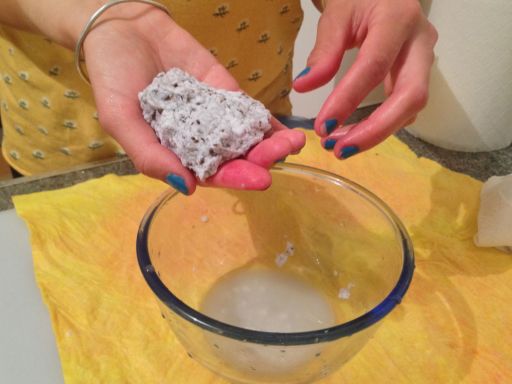
do as i say, not as i do. using food coloring will dye your hands and make unevenly-colored paper
7. Smash it down with the other shammy. Now put a few layers of newspaper on top. Now your flat thing. Smash it down with your hands or your feet or any body part you prefer until allllll the water is gone. Now flip the shammy and pulp sandwich over and squeeze some more.

push it real good
7. Carefully peel the top shammy off the paper. It should come right off. If it doesn’t, you either have too much water left in the paper or you started with too much pulp.
8. When you’re satisfied, peel the paper off and place it on some dry newspaper to dry.
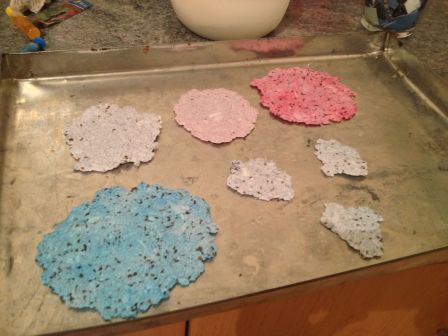
they look like some kind of futuristic meat alternative
9. Okay, after a day or two it’ll be dry and ready to go. You can either use the pieces as they are or use very VERY sharp scissors to cut them into shapes. I did both.
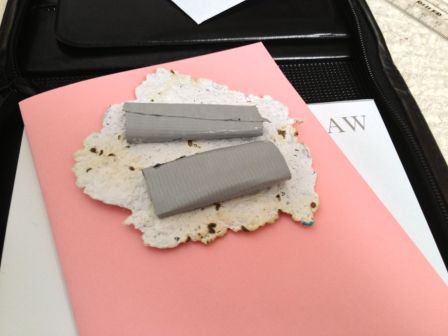
duct tape works for everything
10. Glue or tape the bits of homemade paper to cardstock. That’s it! Write a note inside – don’t forgot to mention that they can plant the card – slap a stamp on it and put that future garden in the mail.
Cacti For All: Don’t Let a Black Thumb of Death Get You Down
It’s fucking spring you guys! I woke up this weekend to an actual honest-to-goodness sunbeam and walked outside wearing only two layers. I saw a woman running in a sports bra which was simultaneously thrilling and confusing because it was still barely 4°C out. But hey, who am I to argue?
When the grass starts poking through the snow and I see my back alley feral cats waddling around full of soon-to-be kittens, the urge to fill my apartment with living things ramps up. By living things, I mean plants not cats. I headed down to Homo Depot to buy a new lil guy for Succulent Spring, but as soon as my girlfriend posted a photo, the warnings started flooding in. “DON’T KILL THIS ONE!” “Please, have mercy…” My friends don’t have a lot of faith in my ability to keep things alive.
Admittedly I have killed quite a few plants (RIP Deceasey the Basil Plant), but I will tut-tut their concern this time. Succulents are a thing both you and I can do!
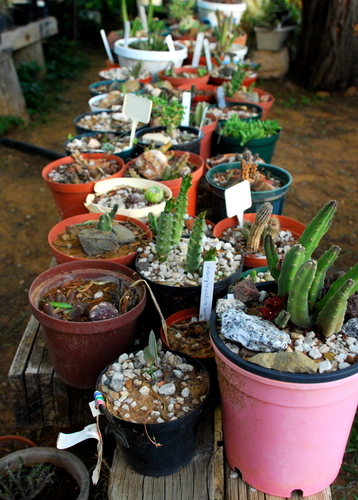
This gardener in ZA put me to shame.
Succulents are The Most Thoughtful Houseplants Ever because they want you to ignore them. They store water in their leaves, trunks and roots making them the independent cats of the plant world. In fact, if you give them too much care or attention, they’ll freak the fuck out. So much like your teenaged emo self, give them plenty of space and they’ll happily chug through life and possibly even flower.
If you’re a Level Eight Gardening Master, you can try your hand at hanging succulent balls or framed succulent gardens while the rest of us will stick to low-lying pots. I usually look to Martha for my basics, but if you want more in depth growing tips, head on over to Cactuslands or the Cactus and Succulent Society of San Jose. You can tell they know what they’re doing by the quality of their web design.
Major Tips
- Give ’em space. Succulents need airflow for their leaves and roots. Choose a soil mix specifically for cacti or combine botanical grade sand and/or grit with your normal potting soil. You want to make sure that the earth stays loose enough for water to quickly drain.
- Keep it dry. Let the soil dry out completely before you give your plants another round. You can get away with watering monthly in the winter and biweekly in the summer.
- Keep ’em hungry. Given that succulents are native to areas with poor soil, too much nitrogen will kill them. If you want to use fertilizer use them at 1/4-1/2 the recommended dose.
- Don’t let them burn. Even though succulents like light, full sun exposure will result in a crispy version of its former self.
If you still have no idea what you’re fucking doing, download an app like Koubachi so your iPhone can chastize you for forgetting to water your plants and not calling your mother.
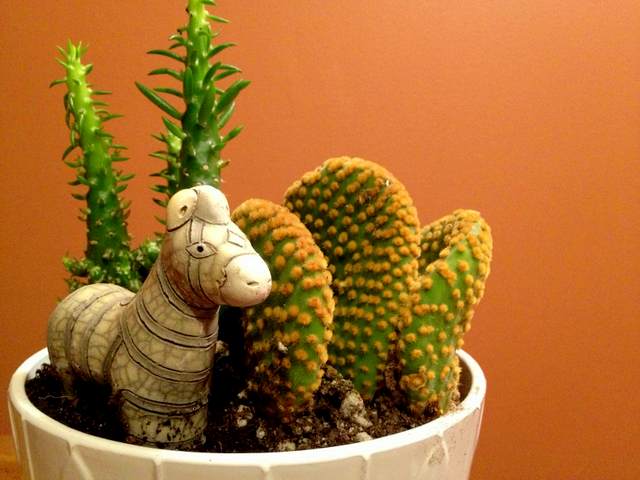
Charlie the Zebra in his natural habitat.
Protip: Add a bit of personality to your plants when you pot! If you fill your containers with shells, knicknacks or souvenirs from your travels, people will be less apt to notice the slowly shrivelling succulents.
If keeping a thing alive makes you secretly (or not so secretly) weep, there are still ways to bring greenery indoors without relying on silk plants from the 1980s. If you do it well, people will applaud your creativity instead of realizing your apartment is a barren wasteland where plants, dust bunnies and heteronormativity go to die.
Crocheted cacti have been on the rise, probably due to all of my fellow Black Thumbs. I told myself I’d learn to crochet this year, but I’ve only mastered chainstitching “toys” for my roomie’s cat. My favourite crocheting Etsy-ers SIXIT and Harvesting Hart both come to the rescue with their Unkillable Plants. If you happen to be friends with your hook, you can crochet a graceful saguaro cactus or some amigurumi cacti with a bit more personality.
If you are made of thumbs, and unfortunately none of them are green, there’s a pathway to plant parenthood for you too. Make an immortal cactus from green socks and pompoms, some extra green felt or a moustache and your sewing machine. Plan B made her own fake cacti using nothing more than fabric, leather, cotton batting, yarn, cardboard and a plant pot. While this looks about 8x easier than any of the crocheted patterns I’d seen, I figured I could do it in even fewer steps while making a somewhat useful knicknack.
Cactus Pincushion
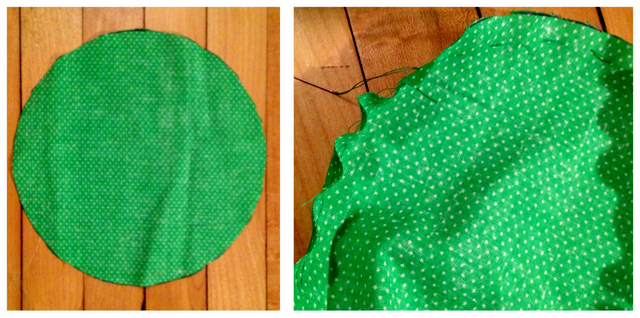
Your journey to Cactus Parent stars by cutting a green circle from whichever fabric you have handy. My circle (and my side plate) just so happen to be 7.5″ in diameter. Loosely stitch around the circumference in a similarly toned thread, staying 1/4″ in from the edge.
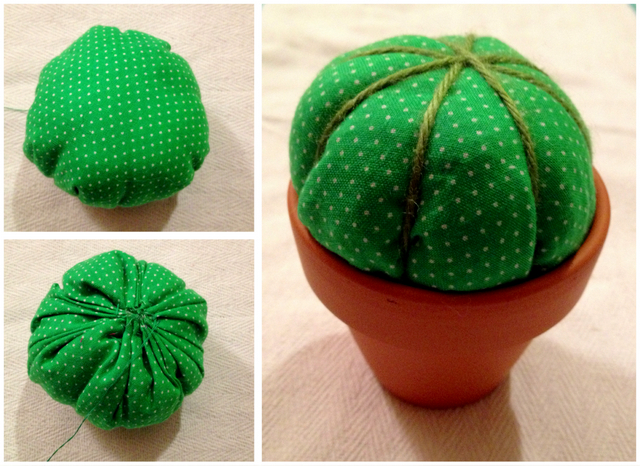
Stuff your soon-to-be-cactus with cotton batting (or in my case, the remnants of a shredded plaid rainbow shirt I found by the side of the road) until it’s delightfully plump. Use a few more stitches to sew it shut. Tightly wrap your ball with yarn, forming eight puffed segments. Stuff it into a mini pot and thread the extra yarn through the hole at the base. Pull on the yarn tightly to ensure a snug fit for your cactus. Look, no glue or cardboard necessary!
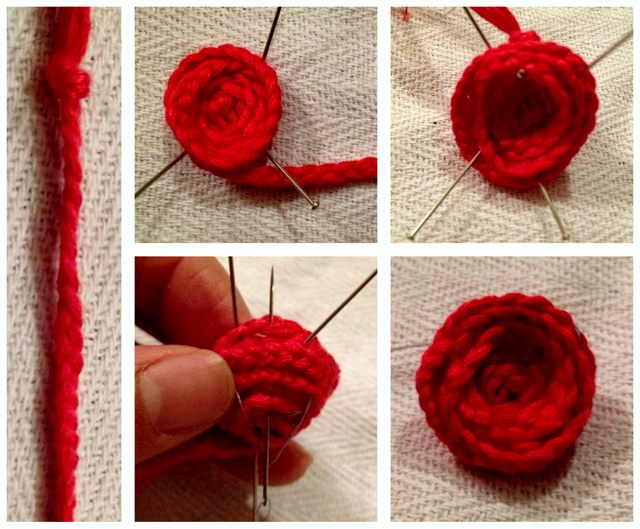
I wanted to add crocheted flowers, but I realize you can’t get that far in life with only a chain stitch. Thankfully Homespun with Heart, proved you could achieve the same effect without ever picking up a hook! Break out the needle and thread instead of her requested glue and cardstock to make flowers with a bit of dimension.
Braid together three 12″-14″ pieces of embroidery floss or yarn, double knotting both ends and cutting off the excess. Spiral the braid around one knot, pinning as you go. Misalign your spirals so the coil takes on a bowl-like shape. When you have few inches left, wrap the rest behind the bud to support the “petals.” Moving outwards from the central knot, stitch in a radial pattern to connect the chain (think the spokes of a basket.) Before you tie off your thread, pull it tightly to cause the flower to take on a bit of a wavy shape. Stitch on the bud, slap in a few needles and bam! Not safe for children!
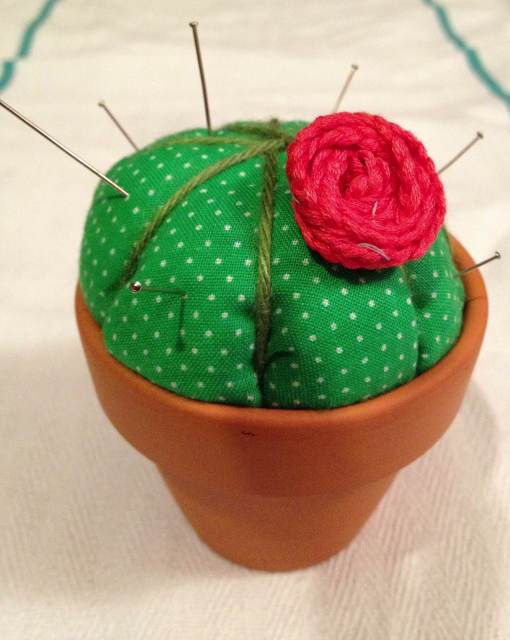
I could have used pink thread, but that would’ve required me to refer to my shopping list.
Depending on how black your thumb is, and how coordinated your other fingers are, you too can make your house a little bit greener! Or at least for a few weeks.

